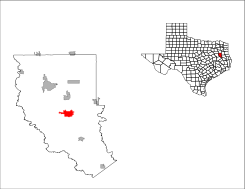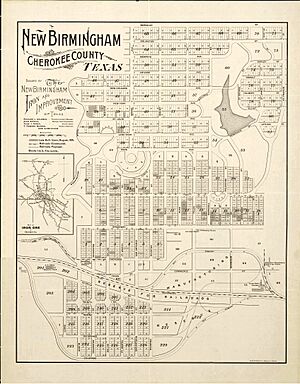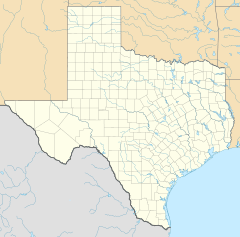New Birmingham, Texas facts for kids
Quick facts for kids
New Birmingham
|
|
|---|---|
 |
|
| Country | United States |
| State | Texas |
| County | Cherokee |
New Birmingham is an abandoned town site in central Cherokee County, Texas, United States. It is now a ghost town. New Birmingham was once a busy town in Texas. People hoped it would become a big industrial center. It was located about two miles southeast of Rusk, a nearby town.
Contents
How New Birmingham Started
New Birmingham started in 1887. It was the idea of Anderson Blevins, who sold sewing machines. He was from Alabama. He traveled through East Texas and found lots of iron ore near Rusk. He knew about Birmingham, Alabama, which was a big industrial city. He thought East Texas could have a similar success.
Blevins talked to his brother-in-law, W. H. Hamman. Hamman was a lawyer and a wealthy oilman. He liked the idea. They found local investors and started a company. It was called the Cherokee Land & Iron Company. They bought land with iron ore. They also got money from investors in St. Louis and New York. By 1888, they had bought about 20,000 acres. They began building a plant to melt the iron ore.
They built two large furnaces. One was named "Tassie Belle" after Blevins' wife. The other was called "Star and Crescent." Both furnaces started making iron. More money came from St. Louis and New York. The company changed its name to the New Birmingham Iron and Land Company. Anderson Blevins was on the board of directors. The company changed its name again in 1890. It became the New Birmingham Iron and Development Co.
The town also built a pipe factory and a brick factory. An electric power plant used coal to make electricity. This brought modern comforts to the new town.
The "Iron Queen of the Southwest"
In September 1889, New Birmingham became an official town. It had banks, a train station, a school, and a newspaper. There was also an ice plant and electricity. All these things made the town seem important and growing.
The town also had the Southern Hotel. This was a very fancy building. It cost over $60,000 to build. A book called History of Cherokee County described it. It said the hotel was the center of fun in New Birmingham. Many famous people stayed there. These included Jay Gould, a railroad owner, and Grover Cleveland, a former president. People from 28 states visited the hotel. This showed how popular New Birmingham was becoming.
In October 1891, the company shared a report. It said that in November 1888, New Birmingham had no houses. It was just woods. But by 1891, it had almost 400 buildings. About 1,500 people lived there. The streets had been built and were lit with electricity. The businesses were in strong brick buildings. The town also had a streetcar system. The Southern Hotel was magnificent and modern.
The report listed the town's industries. These included two furnaces, a pipe factory, and a wood mill. There was also a laundry and a bakery. New Birmingham was called the "Iron Queen of the Southwest." It seemed ready to become a very successful city.
Why New Birmingham Failed
New Birmingham did not last. It slowly faded back into the forest. Two main problems caused its downfall in the 1890s.
Money Problems
The company needed more money. They looked for investors in Britain. A group of British investors, the Baring Brothers, visited New Birmingham. They were impressed by the town and its resources. They agreed to invest about $1,000,000.
However, a new law stopped this investment. It was called the "Alien Land Law of Texas." This law prevented foreign investors from owning land in Texas. Governor James Hogg supported this law. He was from Rusk, near New Birmingham. The company tried to get the governor to change the law. But Governor Hogg would not change his mind. He stood firm against any changes to the law.
Economic Troubles
Then, in 1893, a big economic crisis hit the country. It was called the Panic of 1893. This caused markets to crash. People stopped buying iron. The iron plants in New Birmingham had to close. Without jobs, people started to leave the town.
An explosion badly damaged the "Tassie Belle" furnace. This made things worse. If the economy had been better, this might have been a small problem. But with no demand for iron, it was a big setback.
A Sad Story
Some people in New Birmingham believed a sad story about the town's decline. They said a curse was placed on the town. In 1890, General W. H. Hamman died in the town. A man named S. T. Cooney was arrested. He was found guilty and sent to prison. In 1892, Mr. Cooney was pardoned and released.
Mrs. Hamman was very upset by this. She was also the sister of Tassie Belle Blevins. In her grief and anger, she reportedly wished for the town to be destroyed. She wanted it to be swallowed by the forest.
This story is likely just a legend. The real problem was the loss of W. H. Hamman. His money, influence, and business skills were very important to New Birmingham from the start. By the end of that year, the town was almost empty.
Fading Away
New Birmingham slowly disappeared. Its nearly 400 homes became empty and fell apart. Many buildings were taken down. People tried to bring the town back. In 1899, the Record Brothers thought about building a new iron plant, but it didn't happen. Anderson Blevins tried to reopen the factory in 1907, but another economic crisis, the Panic of 1907, stopped him.
By 1910, the last person had moved out of New Birmingham. During World War I, the ironworks and many remaining buildings were taken apart for scrap metal. The Southern Hotel stayed for a while, but it burned down in 1926. In 1932, the New Birmingham school was torn down to make way for U.S. Highway 69.
Today, an historical marker stands where New Birmingham once was. It was put there in 1966. Tassie Belle Historical Park has some old ruins of the furnace.



